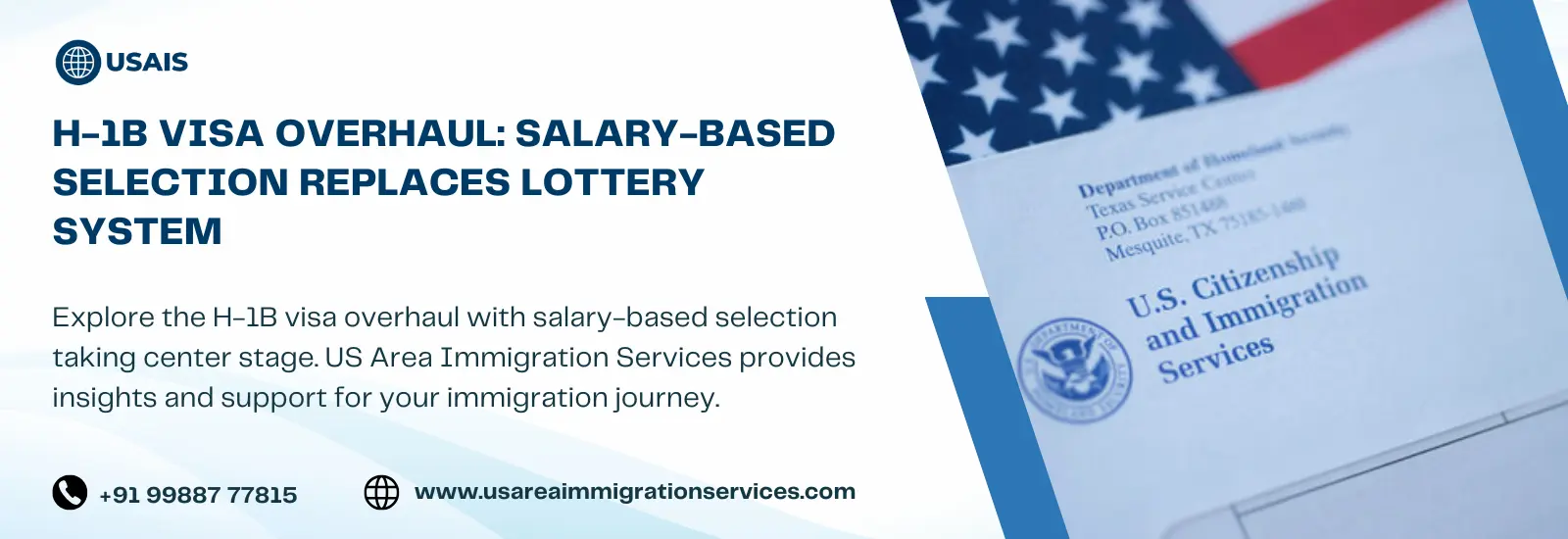The H-1B visa category has been the mainstay of American immigration policy for three decades allowing better foreigners to work in sectors such as technology, engineering, health, and education. In the past, the program relied on the lottery mechanism owing to its popularity and the small number of opportunities available yearly. But there is a shift that has rarely been seen before. Currently, the White House and Congress are discussing changing the allocation of this H-1 B visa in the following manner; There should be an elimination of the lottery system and replace it by adopting the new salary-based selection process.
This has marked a revolution in the selection of skilled human resources for employment in the United States. It further poses significant pertinent issues concerning equity and its effect on the economy and the labour force in America. This blog deepens the understanding of elaborated aspects of the proposed selection system, opportunities and risks, and its implications for employers, foreign employees, and the United States economy.
Understanding the H-1B Visa Program
What is the H-1B Visa?
H-1B visa – this is a program that enables the employees of the United States companies to hire foreign workers in fields that require skilled personnel. Every year the program gives out a maximum of 85,000 visas between skilled workers with a bachelor’s degree from a foreign country 65,000 visas and for workers with a master’s degree or higher from an American institution, 20,000 visas.
Current Lottery-Based Selection System
Get a quick overview of how the USCIS selects H-1B visa petitions because applications for this visa outnumber the annual limit. This lottery approach has been widely complained about and deemed as obscure since it in no way favours important and skilled or high-paid candidates.
The Shift to Salary-Based Selection
What is Salary-Based Selection?
The new system will involve the ranking of applicants with a provision of the offered salaries by the employers. Higher-paid jobs will be given more focus and the best quality and return on investment workers will be hired. This reform does away with the probability of individuals in the selection group and brings worth into a person’s selection.
Why the Change?
The reform is driven by several factors:
- Economic Considerations: Government officials wish to guarantee that H-1B visas are the means to improve the American economy and employ only the best-paid, qualified workers.
- Fairness: People’s opponents believe that the system of lotteries is unfair because all applications that meet the requirements are considered regardless of qualifications, salaries, etc.
- Worker Protections: The salary-based system is also designed to guard against the undercut of American workers because it will provide the foreign worker the going rate for his work.
Key Features of the New System
1. Priority for High Salaries
Those with higher pay will receive the privilege of being granted visas especially because the immigrants seek to attain the return of value with the higher wage earners.
2. Compliance with Wage Levels
This act requires employers to meet the standards of the wage to be paid to the foreign worker that applies to the H-1B program.
3. Focus on High-Skilled Roles
The system inherently provides more attention to the positions that come in handy and which entail a high level of skills or expertise since these positions are paid highly.
4. Transparent Selection Process
Transitioning from the lottery system means that there will be more order and efficiency in the determination of who should be issued visas.
Benefits of Salary-Based Selection
1. Attracting Top Talent
This means that the compensation level has to be improved to allow the U.S. to make the right choices, in this case providing the highest-paid jobs for the best talents globally. This is all clear in light of the country’s long-term macroeconomic and innovation strategy.
2. Reducing Exploitation
The reform aligns itself with the reduction of the possibility of employers exploiting the H-1B program to employ cheap labour, a requirement that has been set in the past. While adopting the new system to focus on high-paying employment, it values the employees as the following illegal labour practices are eliminated.
3. Driving Economic Growth
Intellectual capital in the form of expertise but also provides valuable input in the form of innovation, production and encouragement of enterprise. The salary-based system makes sure that these contributions are optimized.
4. Addressing Public Concerns
Through the focus on La Raza, the system responds to the complaints of opponents of the H-1B program, citing that it provides work to indigenous people of high beginning wages. It is always the public’s concerns that foreigners are being imported as cheap labour, but to provide for skills lacking locally.
Challenges and Criticisms
1. Impact on Small Businesses and Startups
Many individuals employing people might not pay their employees as much as similarly qualified employees in big organizations because they cannot afford to. This could in turn reduce the abilities of such small firms to attract and hire talent that is from other countries hence reducing their innovation.
2. Reduced Opportunities for Entry-Level Workers
Under the new regime, those who fall under the hired low wage earners include, recent graduates and entry-level professionals who may have lesser ability paying for the H- 1B visas. This may impact young professionals willing to establish their careers in the United States most hugely.
3. Regional Disparities
Wages vary significantly across the U.S. due to cost-of-living differences. Employers in lower-cost regions might face challenges competing with those in high-cost urban areas like San Francisco or New York.
4. Administrative Burden
It means new complaints and documentation of salary and many checks on the salary levels that an employee must meet as per the prevailing wage, thus translating into more work on papers for employers and USCIS.
Conclusion
The changes from a lottery scheme to an employer-employee relationship in the H-1B selection process is a big step towards reform among immigration policies in the United States of America. Through promoting the jobs that allow payment of higher wages and salaries, the new system seeks to promote the attraction of the best talent, foster economic growth, and pay first-class wages to foreign talents. But it is not always easy, mainly for people who work for small companies or have recently entered the job market themselves.
While the U.S. is in the process of implementing this reform there ought to be an operating balance in these policies with regards to economic tuning as well as an open-minded mixture of the society and the H-1B program should remain a source of innovation and prosperity.

